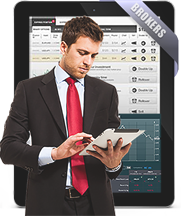- Details
- Trading Signals

These are the results of the 38th Survey of North American Foreign Exchange Volume by the Foreign Exchange Committee.
The FX Volume Survey 2023 by the Foreign Exchange Committee at a glance:
■ Average daily volume declined across most categories compared to the October 2022 survey: spot fell by 10.6%, swaps by 1.9%, and OTC options by 19.4%. The only exception was forward transactions, which increased by 3.2%.
■ Turnover decreased across all counterparty types: volumes reported by “Reporting Dealers” dropped 7.1%, “Other Dealers” fell 9.8%, “Other Financial Customers” declined 2.6%, and “Nonfinancial Customers” decreased 2.4% since October 2022.
- Details
- Trading Signals
Expert Advisors (EAs) Comparison Table

An Expert Advisor (EA) is a software program that integrates with a trading platform—most commonly MetaTrader 4 (MT4)—and executes trades automatically based on predefined instructions set by the trader. These trades are carried out without manual intervention, operating around the clock during market hours (24/5).
Expert Advisors analyze market conditions continuously and can open, modify, and close trading positions based on data such as price, volatility, and volume. They typically include money management features such as position sizing, slippage and spread control, and overall risk management.
EAs are written in specific programming languages depending on the platform they are designed for. For instance, MT4 uses MQL4, while MetaTrader 5 (MT5) uses MQL5.
- Details
- Trading Signals


The Foreign Exchange Market, also known as Forex or the FX market, is the largest and most liquid financial market in the world, with daily trading volumes reaching $4 trillion. Here are some basic facts and tips for those planning to trade in Forex currencies.
The Short History of the Foreign Exchange Market
The Forex market emerged during the 1970s following 30 years of government-imposed restrictions on foreign exchange transactions. The major event that triggered the creation of the Forex market was the collapse of the Bretton Woods Agreement. This agreement had established the global monetary system after World War II and remained in place for about 30 years. Under the Bretton Woods system, all major currencies were pegged to the US dollar, and gold reserves served as the foundation for the dollar’s value.
In the early 1970s, President Richard Nixon announced that the United States would no longer convert US dollars into gold. This led to the adoption of the floating exchange rate system, which soon became the global standard.
The Forex market came into existence as major countries gradually transitioned from fixed exchange rates under Bretton Woods to floating exchange rates.
Today, there are three (3) main exchange rate systems:
-
Floating rate – Exchange rates are determined by supply and demand. (This is the dominant system.)
-
Dollarisation – Some countries choose to link their exchange rate directly to the US dollar (e.g., Panama).
-
Pegged rate – Some countries opt to peg their currency to another currency, such as the euro or the Chinese yuan.
- Details
- Trading Signals
RISK MANAGEMENT -BASIC CONCEPTS AND RULES

Risk management is perhaps the most important component of long-term trading success. This tutorial covers some basic concepts and rules of effective risk management.
Diversification and the 25-2% Rule
Diversification is the holy grail of financial investing. The benefits of diversifying positions in investing are far greater than the average trader might imagine.
What does Diversification mean?
Diversification simply means not putting all your eggs in one basket. In other words, it involves becoming more varied by including a wide range of investments in the same portfolio.
The 25-2% Rule
The first percentage (25%) refers to the asset class, and the second (2%) to the individual asset, therefore:
(i) Don’t invest more than 25% of your portfolio in the same asset class (e.g. stocks, precious metals, Forex currencies, bonds, etc.)
(ii) Don’t invest more than 2% of your portfolio in a single trade position (e.g. a specific stock, a Forex pair, etc.)
Professional traders may employ strategies that risk no more than 0.5% per trade.
Controlling Capital Leverage
Capital leverage increases profit potential but also leads to higher trading costs:
(i) Increases Profit Potential
(ii) Increases Loss Potential
(iii) Paying more Trading Cost
If (i) and (ii) are considered equal, then the trader consistently faces higher trading costs. If you trade by applying 100:1 leverage, there is a 95% probability that you will lose the entire account within 2–3 months. Professional traders avoid using leverage greater than 5:1.
Forex Trade Signal Reviews
A Forex signal provider is a professional trader or a team of professional traders that offer a suggestion for entering a trade. This suggestion includes a specific price and time, and usually a stop-loss, and a take-profit order. The trading signal is provided to subscribers of the forex signaling service. This is what is included in a trading signal:
(1) The specific price and time to open a position
(2) The direction of the market
(3) A stop-loss order and a take-profit order
(4) The price level at which traders should move their stop-orders to lock their profits


